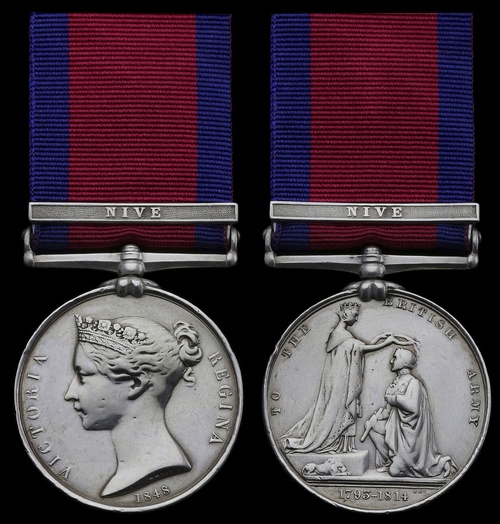
Auction: 20002 - Orders, Decorations, Medals & Space Exploration
Lot: 12
The superb Military General Service Medal awarded to Private Thomas Fowlis (Fowles) of the 3rd Battalion 1st Foot Guards who, after service in the Peninsular War, later fought at Waterloo in Lord Saltoun's Light Company in the defence of Hougoumont
Military General Service 1793-1814, 1 clasp, Nive (T. Fowlis, 1st Foot Guards), good fine, heavily polished, small edge knocks
Thomas Fowles, born in Devizes, enlisted in the 3rd Battalion 1st Foot Guards on 5 April 1813; he was part of a reinforcement for the battalion, currently in the Iberian Peninsula which, along with the 1st battalion of the 1st Guards, had been struck down with a particularly virulent strain of fever which had already carried off over 700 veteran Guardsmen. Upon joining the battalion, it appears that Fowles earned a place in its' Light Company - commanded by none other than Captain Alexander Frazer, 17th Lord Saltoun, who was to make a name for himself two years later at Waterloo...
After crossing the Bidassoa river, the 3/1st Guards saw some action in the advance again French forces entrenched in the foothills and slopes of the Pyrenees; this being prime skirmishing country it is highly likely Fowles and fellow members of the Light Company were in action on a regular basis. At the Nive (9 - 13 December 1813), the Guards were held in reserve for much of the day, partly owing to the terrible weather. Nevertheless they participated in some fighting and serious skirmishing thoughout the following days
The 3rd Battalion also took part in the confused - and bloody - night action at Bayonne, which was additionally entirely unnecessary as peace had recently been declared: the Guards sustained some 500 casualties including several senior officers killed and wounded.
'A pattern to the Army both as a man and a soldier
Upon the commencement of the Hundred Days' Campaign, the 2/1st and 3/1st Guards formed the First Guards Brigade; after the inconclusive action at Quatre Bras on 16 June and Wellington's withdrawal to the field of Waterloo, Lord Saltoun's Light Company - of which Fowles was still a member - was ordered to assist in the defence of the Chateau d'Hougoumont; Fowles must undoubtedly have assisted in turning the farmouse and buildings into a makeshift fortress - adding loopholes, firesteps and barricades - to await the inevitable French onslaught.
Under Napoleon's direction and led by his brother Jerome, the Battle of Waterloo commenced with an attempt to take Hougoumont by storm; throughout the day the fight for the chateau became a battle within a battle, the Allies tenaciously clinging on to their defensive position despite an entire French Division being thrown at them; Saltoun had four horses shot from under him during the battle and, remarkably, once the defence was stabilised towards the end of the day and it was clear the French were massing for the Emperor's final throw of the dice, he and his Company were ordered back up to the ridge. It was here that Saltoun assumed temporary command of the Brigade, so many senior officers having become casualties; undoubtedly Fowles witnessed the advance of the French Imperial Guard and their subsequent destruction due to deadly volleys of Allied musketry - it was also at this point that Wellington gave his famous order: "Now Maitland, now's your time! Up Guards, and at 'em!" Waterloo was won and both Saltoun & Fowles had survived without a scratch.
From Waterloo, the 3/1st Foot Guards participated in the storming and subsequent surrender of Peronne (27 - 28 June 1815) in which Saltoun and his Light Company yet again distinguished themselves by carrying an outwork with little loss. Upon peace being declared once again, the battalion remained in France and around Paris until 1818 when it returned home to recommence peacetime - and public - duties in London.
Fowles remained in the Army until November 1835; subsequent Census returns list him as an 'Out Pensioner' (1851) living in Joy Street, Shoreditch, with wife Charlotte (born 1820) and children Charles, Joseph, Caroline and Rachel. Interestingly, at the time of his death on 31 July 1875 he is noted as a 'Watchman' of the Honourable Artillery Company and was undoubtedly based at Armoury House in The City; fitting employment indeed for an experienced, steady, and reliable old veteran with strong links to his old regiment, the 1st (by then Grenadier) Regiment of Foot Guards.
Sold with a comprehensive file of copied research, copied service records and associated copied papers.
Subject to 20% VAT on Buyer’s Premium. For more information please view Terms and Conditions for Buyers.
Sold for
£950
Starting price
£600




